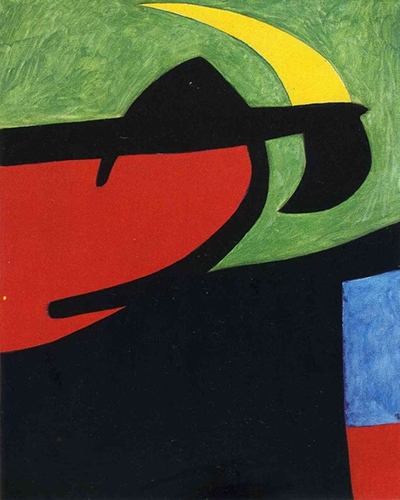This scene from Miro is about as abstract as it gets - reducing a complex scene into just a few shapes, alongside a limited palette.
We immediately spot moonlight as delivered with a curved shape that is yellow and black, with a strong line cutting it in two. The upper half of the overall canvas is green, capturing the rest of the sky, whilst below is black with a few touches of blue and red. Without the title, it would be virtually impossible to understand just as much as we do. The depiction of peasants within art was partly a political choice, a desire to draw attention to the poorer elements of society rather than to promote the rich. Miro was connected to the Surrealists and many of them were politically biased towards the extreme left, with some regarded as communists - this type of content would have been entirely consistent with those types of political beliefs.
The Hunter from 1924 is when Miro first made use of the peasant within his paintings and then went on to use this subject over several years. Interestingly, the particular artwork that you find within this page was completed as late as 1968, meaning that he revisited the topic over an extended period of time. It is 130cm wide and 162cm tall and the original title given to it by the artist was Paysan catalan au clair de lune, which we have translated into Catalan Peasant in the Moonlight. Miro made use of different tones of acrylic in order to put this painting together and considering the simplicity of the composition, it is most likely to have been completed in a short amount of time.
The original artwork is now believed to be owned by the Fundació Joan Miró, Barcelona, which also offers many of his most famous paintings for your enjoyment. It is one of a number of museums dedicated to this artist's work, though some of his original pieces can also be found in other, more varied collections around the world. Miro would often use earth and night within his abstract compositions and in this example the former is represented by the peasant worker. Red tones are used for both the land itself and also the peasant's face, which connects this idea together. There are also some similarities between the moon and a sickle, which adds a further dimension to his planning behind this artwork.




